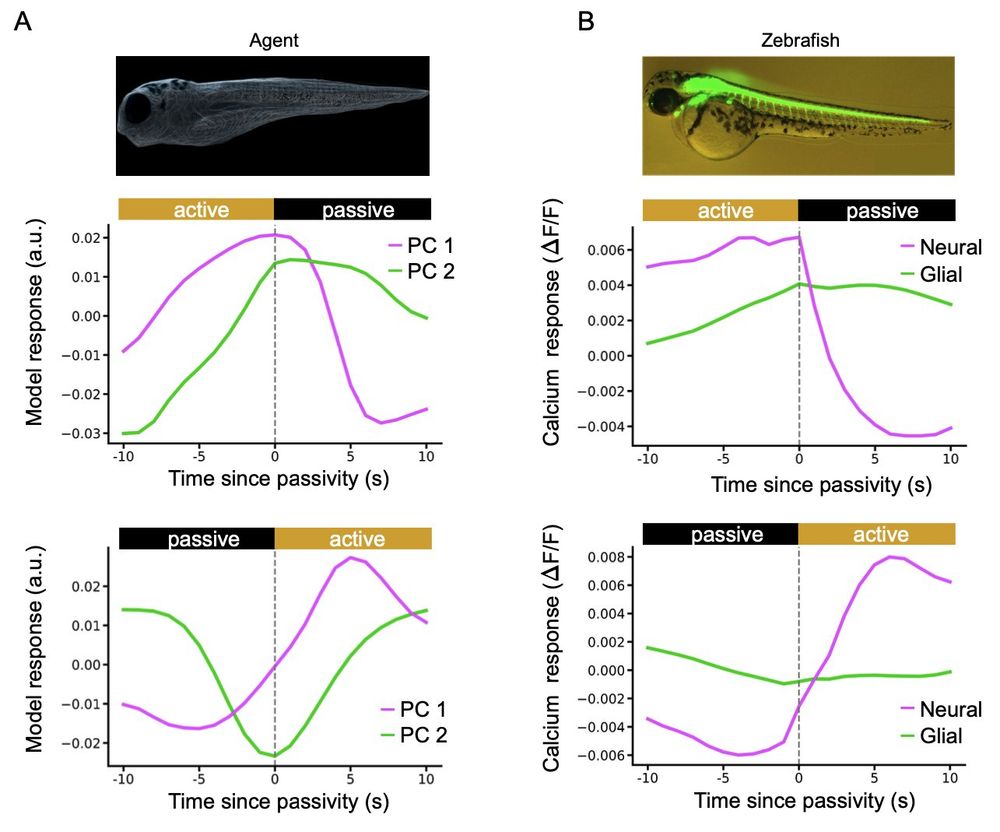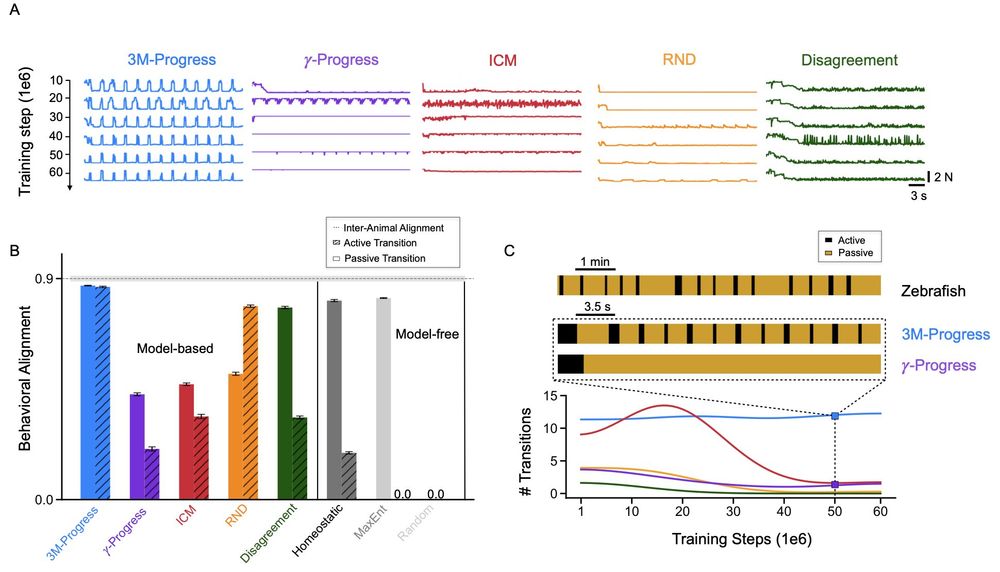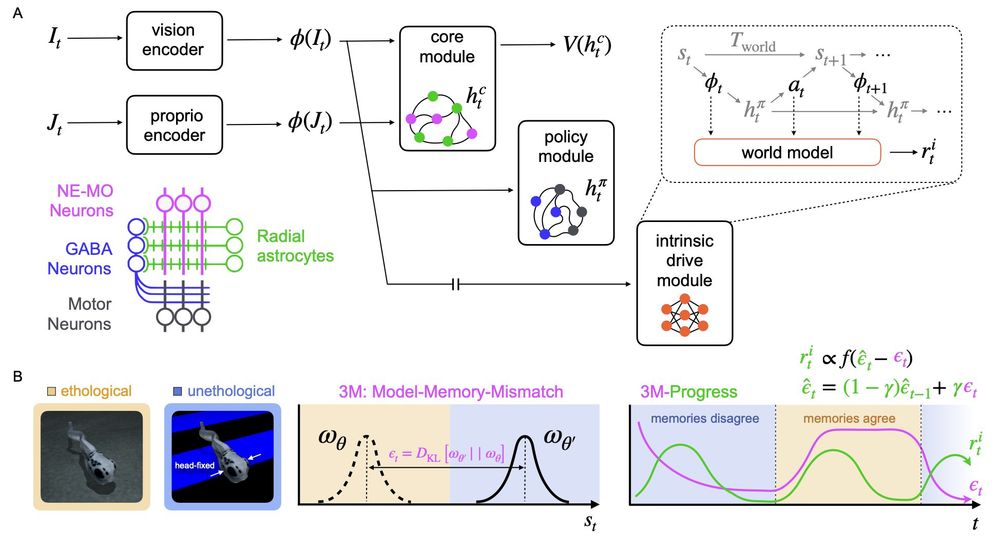
10/ Animal-like autonomy—flexibly adapting to new environments without supervision—is a key ingredient of general intelligence.
Our work shows this hinges on 1) a predictive world model and 2) memory primitives that ground these predictions in ethologically relevant contexts.
05.06.2025 20:03 — 👍 19 🔁 2 💬 3 📌 0

9/ Finally, we show that the neural-glial circuit proposed in Mu et al. (2019) emerges from the latent dynamics of 3M-Progress agents.
Thanks to my collaborators Alyn Kirsch and Felix Pei, and to Xaq Pitkow for his continued support!
Paper link: arxiv.org/abs/2506.00138
05.06.2025 20:03 — 👍 16 🔁 0 💬 1 📌 0

8/ 3M-Progress agents achieve the best alignment with brain data compared to existing intrinsic drives and data-driven controls. Together with the behavioral alignment, 3M-Progress agents saturate inter-animal consistency and thus pass the NeuroAI Turing test on this dataset.
05.06.2025 20:03 — 👍 11 🔁 0 💬 1 📌 0

7/ 3M-Progress agents exhibit stable transitions between active and passive states that closely match real zebrafish behavior.
05.06.2025 20:03 — 👍 12 🔁 0 💬 1 📌 0

6/ The agent learns a forward dynamics model and measures the divergence between this model and a frozen ethological memory. This model-memory-mismatch (3M) is tracked over time (w/ gamma-progress) to form the final intrinsic reward.
05.06.2025 20:03 — 👍 13 🔁 0 💬 1 📌 1

5/ First, we construct two environments extending the dm-control suite: one that captures the basic physics of zebrafish ecology (reactive fluid forces and drifting currents), and one that replicates the head-fixed experimental protocol in Yu Mu and @mishaahrens.bsky.social et al. 2019.
05.06.2025 20:03 — 👍 14 🔁 1 💬 1 📌 0
4/ To bridge this gap, we introduce 3M-Progress, which reinforces behavior that systematically aligns with an ethological memory. 3M-Progress agents capture nearly all the variability in behavioral and whole-brain calcium recordings in autonomously behaving larval zebrafish.
05.06.2025 20:03 — 👍 16 🔁 0 💬 2 📌 0
3/ Existing model-based intrinsic motivation algorithms (e.g. learning progress, prediction-error) exhibit non-stationary and saturating reward dynamics, leading to transient behavioral strategies that fail to capture the robust nature of ethological animal behavior.
05.06.2025 20:03 — 👍 16 🔁 0 💬 2 📌 0
2/ Model-based intrinsic motivation is a class of exploration methods in RL that leverage predictive world models to generate an intrinsic reward signal. This signal is completely self-supervised and can guide behavior in sparse-reward or reward-free environments.
05.06.2025 20:03 — 👍 22 🔁 0 💬 1 📌 0
1/ I'm excited to share recent results from my first collaboration with the amazing @anayebi.bsky.social
and @leokoz8.bsky.social !
We show how autonomous behavior and whole-brain dynamics emerge in embodied agents with intrinsic motivation driven by world models.
05.06.2025 20:03 — 👍 117 🔁 24 💬 2 📌 19
Neuroscientist @Janelia, HHMI
www.ahrenslab.org
CS / Psych / Neuro Prof @ Stanford. Interested in NeuroAI and Bach. And Bonsai.
Professor a NYU; Chief AI Scientist at Meta.
Researcher in AI, Machine Learning, Robotics, etc.
ACM Turing Award Laureate.
http://yann.lecun.com
Doing cybernetics (without being allowed to call it that). Assistant Professor @ Brown. Previously: IBM Research, MIT, Rutgers. https://kozleo.github.io/
Assistant Professor of Machine Learning, Carnegie Mellon University (CMU)
Building a Natural Science of Intelligence 🧠🤖
Prev: ICoN Postdoctoral Fellow @MIT, PhD @Stanford NeuroAILab
Personal Website: https://cs.cmu.edu/~anayebi
official Bluesky account (check username👆)
Bugs, feature requests, feedback: support@bsky.app






